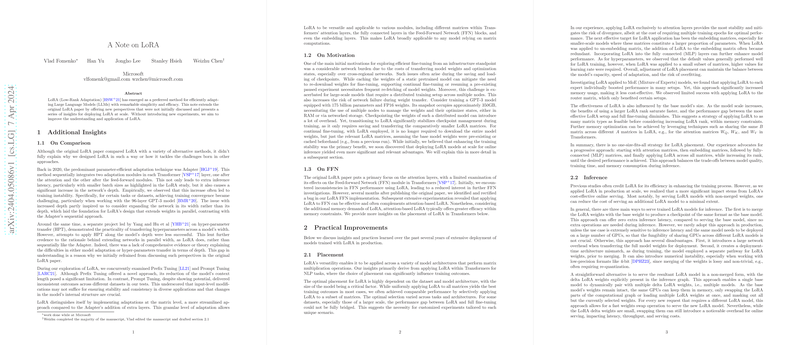A Note on LoRA: Insights and Practical Applications
The paper "A Note on LoRA" by Vlad Fomenko et al. provides a deeper analysis of LoRA (Low-Rank Adaptation), a method initially proposed for efficiently fine-tuning LLMs. It aims to extend the understanding of LoRA without presenting new experiments, by contrasting it with other parameter-efficient adaptations and offering detailed insights from extensive real-world deployment at scale.
Critical Analysis of Alternative Approaches
The paper revisits the predominant parameter-efficient adaptation techniques predating LoRA, such as Adapters and Hyper-Parameter Transfer (HPT). Adapters sequentially integrate adaptation modules within Transformer layers, which often leads to increased inference latency and training instability, especially in deep models like GPT-3. Conversely, HPT's ineffectiveness when applied to model depth further validates the design choice of parallel weight extension as adopted by LoRA.
LoRA's matrix-level adaptation contrasts fundamentally with Prefix Tuning and Prompt Tuning by offering modifications within a model's internal structure rather than just at the input, thereby addressing stability and consistency issues. This is particularly beneficial for various modules, including attention, feed-forward network (FFN) blocks, and embedding layers, often integral to NLP tasks.
Practical Insights and Deployment
A significant portion of the paper discusses practical insights derived from deploying LoRA models at scale. One key advantage is the reduced network burden during fine-tuning and checkpoint management, particularly in distributed training setups. LoRA’s efficacy in large-scale online inference is paramount, enabling cost-effective serving by reducing the need to handle vast amounts of model weights.
- Model Placement: The placement of LoRA significantly impacts training outcomes. Typically, uniformly applying LoRA across all matrices yields optimal results. However, selective application to matrices, especially attention layers, can provide stability and efficiency, albeit necessitating multiple epochs for convergence.
- Inference Strategies: LoRA models can be served using merged or non-merged weights. While merging can reduce latency, the non-merged approach is often preferred for its flexibility, allowing dynamic pairing of base models with different LoRA weights. This method facilitates serving numerous LoRA models with minimal additional latency and costs.
- Optimization and Techniques: The paper explores batch routing and stacked tensors to support efficient batched inference, drawing parallels with techniques like Mixture-of-Experts (MoE). These methods enable serving a large number of requests targeting different LoRA models, further enhancing throughput and reducing inference costs.
Additional Explorations
The authors experimented with adaptive LoRA, dynamically determining the rank dimension during training, which showed quality improvements but faced infrastructure challenges during inference, primarily due to increased memory fragmentation. Augmentations involving non-linearity, analogous to DenseNet for LoRA weights, and a combination of LoRA with other efficient training techniques were also explored. Despite some dataset-specific improvements, the added complexity often hindered integration and did not justify the trade-offs in large-scale models.
Future Directions
Several opportunities for enhancing LoRA and other parameter-efficient fine-tuning methods are identified:
- Model Update Efficiency: Addressing the necessity to re-train all LoRA models when the base model changes remains a substantial challenge. Developing solutions for this would significantly improve the practicality and cost-effectiveness of LoRA in dynamic environments where models frequently evolve.
- Training Efficiency: While LoRA shines during inference, its training efficiency for large-scale models remains an area for improvement. Research into pre-computed or zero-shot LoRA parameters (e.g., via hypertuning) holds potential but requires significant advancements before practical adoption.
- Quantization-aware Training: With the emerging trend of low-precision model training, integrating LoRA effectively into such workflows is crucial. Techniques to manage quantization discrepancies, such as those proposed by recent studies (e.g., LOFTQ, LQLoRA), need further exploration and refinement.
- Application Beyond NLP: Expanding LoRA’s application to other modalities, particularly in domains like computer vision (e.g., diffusion models), calls for tailored approaches that leverage the inherent mechanisms of these models.
Conclusion
"A Note on LoRA" offers a comprehensive survey of the methodology’s theoretical underpinnings, practical deployment strategies, and potential research directions. By contrasting LoRA with other adaptation techniques and detailing its scalable implementation, the paper provides valuable insights for enhancing model efficiency and performance in both research and production contexts. The continued exploration and refinement of LoRA, particularly in the face of evolving model architectures and quantization techniques, promises exciting future developments in the field of AI.
